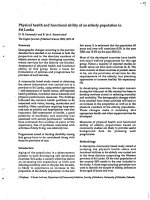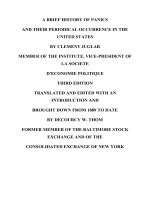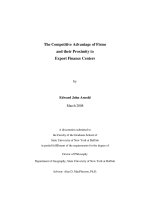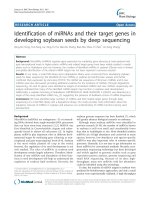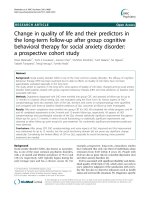THE ETHNIC IDENTITY OF MALAYS IN SRI LANKA THE CHALLENGES OF ASSIMILATION AND THEIR RESPONSES
Bạn đang xem bản rút gọn của tài liệu. Xem và tải ngay bản đầy đủ của tài liệu tại đây (2.94 MB, 438 trang )
THE ETHNIC IDENTITY OF MALAYS IN
SRI LANKA: THE CHALLENGES OF
ASSIMILATION AND THEIR RESPONSES
ABOOBACKER RAMEEZ
NATIONAL UNIVERSITY OF SINGAPORE
2015
THE ETHNIC IDENTITY OF MALAYS IN
SRI LANKA: THE CHALLENGES OF
ASSIMILATION AND THEIR RESPONSES
ABOOBACKER RAMEEZ
M.Phil (UPDN)
A THESIS SUBMITTED
FOR THE DEGREE OF DOCTOR OF
PHILOSOPHY
DEPARTMENT OF MALAY STUDIES
NATIONAL UNIVERSITY OF SINGAPORE
2015
DECLARATION
I hereby declare that this thesis is my original work and it
has been written by me in its entirety. I have duly
acknowledged all the sources of information which have
been used in the thesis.
This thesis has also not been submitted for any degree in any
university previously.
Aboobacker Rameez
May 15, 2015
i
ACKNOWLEDGEMENTS
The submission of a PhD dissertation is undoubtedly one of the
greatest moments in the life of an academic. As an academic, I too share the
same feelings at the moment. I had to struggle through numerous challenges
before I could finally complete this dissertation. I would like to thank all those
who helped me overcome those challenges and realise my dream of
completing the PhD at a reputed institute like NUS.
First of all, I am grateful to the Singapore government for offering me
an opportunity to read for my doctoral degree at the NUS under the research
scholarship, which I was privileged to receive.
I would like to express my sincere gratitude to my supervisor,
Associate prof. Syed Farid Alatas for the great confidence he had in me and
selecting me to do my PhD at the Department of Malay Studies. His
constructive feedback, and constant encouragement and guidance helped me in
no small way towards the completion of the present study. He has always been
congenial and incredibly helpful. I am also grateful to my thesis committee
members such as Dr Noor Aisha and Dr Suriani Suratman for their invaluable
insights and feedback into my study. I also offer my gratitude to Dr Khairudin
Aljunied, Dr Maznah Mohamed, Dr Sher Banu, and Dr Azhar Ibrahim from
the Department of Malay Studies for their constant support. My special thanks
also go to Rasmidah mdm and Dahila mdm from the Department of Malay
Studies for facilitating the administrative works related to my study and for
being so benevolent and affable to me.
ii
I am indebted to Dr MGM Razaaq, Senior Lecturer in Sociology,
University of Peradeniya, for inspiring me from the beginning to engage in
this sort of study and sharing with me his wealth of experience. I also owe a
special debt of gratitude to Prof. B.A. Hussainmiya, from the University of
Brunei Darussalam, for guiding me in the proper direction of the study and
providing me with some of the invaluable materials indispensible to this study.
I also extend my thanks to Dr Mohammad Maruf, who has now retired from
Ceyney University, the USA, for sharing his thoughts over my study.
Many colleagues and friends from my home university, the South
Eastern University of Sri Lanka, have been extremely supportive over the
years. In particular I would like to thank Dr SMM.Ismail, Vice Chancellor of
SEUSL, Dr MAM. Rameez, Senior Lecturer in languages, Dr SM.Ahamed
Lebbe, Head/Department of Social Sciences, MA. Jabbar, Dean/Faculty of
Arts and Culture, SM. Aliff, MM. Fazil, Mr. MAM.Fowsar, Dr ALM. Riyal,
and Dr MIM. Kaleel for their untiring support in so many ways.
This study would not have been possible without the considerable
support of members of the Malay community in Sri Lanka during my field
works. They are too many to name individually, but they know who they are. I
would like to extend my heartfelt thanks to Dr Hussainmiya, Dr Ramola,
BDK.Saldin, Iqram Cuttlian, Alamuddin, Honeida Packeer, TK.Azoor, Nafeel
Dulapaandan, Rinosa, Tuan Sahabdeen, TK. Samad, Yosuf Harith, Dada
Packeer Ali and others for providing materials relevant to the study and
assisting me in so many ways.
iii
I must also thank Mohamed Faizal for patiently proof reading at such a
short notice. Finally, the biggest thank you goes to my long-suffering family.
My parents have been of rock solid support to me – early in my life they
nurtured my academic ambitions. I wish my father, who passed away in the
middle of my study, were alive today to see the completion of this work. My
special thanks go to my wife, Zilmayathu Shifana and my son, Ahamed
Faidhy, for their sacrifices and patience; my long absence as husband and dad
caused them enormous difficulties.
iv
TABLE OF CONTENTS
Acknowledgements i
Table of contents iv
Abstract x
List of Tables and Diagrams xii
List of Figures and Maps xiii
List of Abbreviations xiv
CHAPTER ONE:
INTRODUCTION
1.1 : Background of the study…………………………… ………………01
1.2 : Aim of the study…………………………………………………… 10
1.3 : Research questions…………………………………………………. 12
1.4 : Rationale of the Study……………………………………………… 13
1.5 : Scope of the study………………………………………………… 15
1.6 : Research Methodology…………………………………………… 20
1.7 : Chapter Outline…………………………………………………… 23
CHAPTER TWO:
LITERATURE REVIEW AND THEORITICAL FRAMEWORK
2.1 : Introduction…………………………………… …………………… 27
2.2 : Literature Review……………………………………………………. 27
2.2.1 : Works on Sri Lankans……………………………………… 28
2.2.1.1 : Sri Lankan Tamils………………………………… 28
2.2.1.2 : Sri Lankan Sinhalese(Buddhists) …………………… 31
2.2.1.3 : Sri Lankan Moors…………………………………… 34
2.2.1.4 : Sri Lankan Malays…………………………………. 39
2.2.2 : Works on Southeast Asian Malays…… ……………………. 52
2.2.2.1 : Works on constructivism……………………………. 52
2.2.2.2 : Works on assimilation………………………………. 58
v
2.3 : The general conceptual and theoretical framework
on ethnic identity……………………………………………………. 62
2.3.1 : Ethnic groups and ethnic identity…………………………… 62
2.3.2 : Theories of Ethnic identity…………………………………. 66
2.3.2.1 : Primordial perspective on ethnic identity…………… 67
2.3.2.2 : Situationalist perspective on ethnic identity………… 69
2.3.2.3 : Constructivist perspective of ethnic identity………… 70
2.4 : Theories of assimilation……………………………………………. 80
2.4.1 : Acculturation……………………………………………… 84
2.4.2 : Structural assimilation (integration)……………………… 86
2.5 : Theory of cultural pluralism…………………………………………. 88
2.6 : Theoretical framework of the study…………………………………. 90
2.7 : Summary…………………………………………………………… 96
CHAPTER THREE:
GENESIS OF SRI LANKAN MALAYS AND THEIR HISTORICAL
SETTLEMENT IN THE COUNTRY
3.1 : Introduction……………………………………………………… 97
3.2 : Genesis of Sri Lankan Malays…………………………………. 97
3.2.1 : Malays in Sri Lanka during the pre-colonial period……… 98
3.2.2 : Malays in Sri Lanka during the colonial period……… 100
3.2.2.1 : Malays during the Portuguese occupation of
Sri Lanka …………………………………………… 100
3.2.2.2 : Malays during the Dutch occupation of Sri Lanka…… 104
3.2.2.3 : Malays during the British occupation of Sri Lanka… 108
3.2.3 : Malays in Sri Lanka during the post-colonial period……… 116
3.3 : Malay Settlements and their present demographic trends…… 118
3.3.1 : Historical Malay Settlements in Sri Lanka………………… 118
3.3.2 : The present demographic dynamics of Sri Lankan Malays… 123
3.4 Summary………………………………………………………… 129
vi
CHAPTER FOUR:
ETHNIC IDENITITY FORMATION OF SRI LANKAN MALAYS
4.1 : Introduction…………………………… ……………………………. 131
4.2 : Ethnic identity markers of Sri Lankan Malays…………………… 132
4.2.1 : Physical Characteristics……………………………………… 137
4.2.2 : Malay language …………………………………………… 143
4.2.2.1: Contestation between Sri Lankan Malay (SLM)
and Standard Malay(SM)………………………… 151
4.2.3 : Ancestry…………………………………………………… 160
4.2.4 : Culture……………………………………………………… 166
4.2.4.1: Malay costumes…………………………………. 166
4.2.4.2: Malay culinary fare………………………………. 170
4.2.4.3: Matrimonial and other cultural practices……… 173
4.2.4.4: Malay music and dances…………………………. 174
4.2.5 : Religion …………………………………………………… 180
4.2.5.1: Establishment of Mosques by Malays…………… 186
4.3 : Ethnic identity formation of Sri Lankan Malays and theories on
ethnic identity…………………………………………………… 192
4.3.1 : Primordial theory on Malay ethnic identity……………… 192
4.3.2 : Constructivist theory on Malay ethnic identity ………… 195
4.3.2.1: Construction of identity through Sri Lanka
Malay language………………………………… 199
4.3.2.2: Construction of identity through ancestry………… 206
4.3.2.3: Construction of identity through culture………… 208
4.3.2.4: Construction of identity through religion………… 211
4.3.2.5: Construction of identity in contradiction to Moor
identity ………………………………………… 216
4.3.3 : Theoretical discussion on Southeast Asian Malay identity and
Sri Lankan Malay identity ……………………………… 220
4.4 : Summary……………………………………………………………. 222
vii
CHAPTER FIVE:
CHALLENGE OF ACCULTURATION ON ETHNIC IDENTITY OF
MALAYS
5.1 : Introduction………………………………………………………… 225
5.2 : Acculturation and Malay ethnicity………………………………… 227
5.2.1 : Additive acculturation………………………………………. 228
5.2.2 : Substitutive acculturation……………………………………. 237
5.3 : Causes of substitutive acculturation………………………………… 250
5.3.1 : Lack of prejudice or discrimination against Malays
by others…………………………………………………… 251
5.3.2 : Influence of Tawheed Jamath (Wahhabi movement),
Thabligh Jamath and other Islamic renaissance movements … 255
5.3.3 : Interaction of Malays with dominant ethnic groups…………. 258
5.3.4 : Forced acculturation at schools and other places………… 261
5.3.5 : Westernization and urbanization……………………………. 263
5.3.6 : Scattered and living in areas dominated by
other communities…………………………………………… 264
5.3.7 : Disinterest of the Malay younger generation………………… 266
5.4 : Summary……………………………………………………………… 267
CHAPTER SIX:
CHALLENGES OF STRUTURAL ASSIMILATION
(INTEGRATION) ON ETHNIC IDENTITY OF MALAYS
6.1 : Introduction………………………………………………………… 270
6.2 : Structural assimilation and Malay ethnicity…………………………. 271
6.2.1 : Impersonal contacts of structural assimilation between
Malays and Moors………………………………………… 278
6.2.2 : Personal contacts of structural assimilation between
Malays and Moors…………………………………………. 286
6.2.3 : Impersonal contacts of structural assimilation between
Malays and Sinhalese……………………………………… 302
6.2.4 : Personal contacts of structural assimilation between
Malays and Sinhalese… …………………………………… 311
viii
6.3 : Causes of structural assimilation …………………………………… 324
6.3.1 : Mixed educational system and working environments,
and closed neighborhood with non-Malays………………… 325
6.3.2 : Economic Reasons…………………………………………… 328
6.3.3 : Shared religion-Islam……………………………………… 329
6.3.4 : Easy going nature with trilingualism and flexible
Interpretation of Islam…………………………………………332
6.3.5 : Freedom to choose their partners…………………………… 334
6.3.6 : Lack of proper socialization………………………………… 335
6.3.7 : Thinly distributed settlement/interspersed settlement
among the core groups………………………………………. 336
6.3.8 : Conspiracy of conversion…………………………………… 338
6.4 : Summary……………………………………………………………… 343
CHAPTER SEVEN:
RESPONSES OF MALAYS TO THE CHALLENGE OF
ASSIMILATION AND THE OUTCOMES OF ASSIMILATION
7.1 : Introduction………………………………………………………… 345
7.2 : Measures taken by Malay elites and their organizations
in response to the challenge of assimilation………………………… 346
7.2.1 : Sri Lanka Malay Association(SLMA)………………………. 346
7.2.2 : Conferensi Melayu Sri Lanka (COSLAM)………………… 351
7.2.3 : Sri Lanka United Malay Organization (SLUMO)…………… 355
7.2.4 : Mabole Malay Association………………………………… 356
7.2.5 : Women’s Association of Sri Lankan Muslims (WASLAM)… 358
7.2.6 : Sri Lanka Malay Ulema Association…………………………. 360
7.3 : Outcomes of Assimilation……………………………………………. 367
7.3.1 : Cultural pluralism…………………………………………… 368
7.3.2 : Hybridity of Malays………………………………………… 374
7.4 : Summary……………………………………………………………… 376
ix
CHAPTER EIGHT:
CONCLUSION
8.1 : Introduction………………………………………………………… 379
8.2 : Summary of the findings……………………………………………. 379
8.3 : Significance of the findings of the study……………………………. 383
8.4 : Limitations of the study……………………………………………… 392
8.5 : Recommendation for further works………………………………… 393
BIBILIOGRAPHY…………………………………………………… 395
APPENDIX I……………………………………………………………… 408
Key informant interview guide with Malays……………………… 408
APPENDIX 11……………………………………………………………. 411
Key informant interview guide with non-Malays………………… 411
APPENDIX 111…………………………………………………………… 413
Focus group discussion guide with Malays……………………… 413
APPENDIX 1V……………………………………………………………. 414
Participant information Sheet and Consent Form (IRB form)…… 414
APPENDIX V……………………………………………………………. 419
Social Profile of Malay Respondents/Interviewees……………… 419
APPENDIX V1……………………………………………………………. 421
Social Profile of Non-Malay Respondents………………………… 421
x
ABSTRACT
As an ethnic minority within a religious minority, Malays in Sri Lanka
present a fascinating and multifaceted case of ethnic identity formation. While
there has been a considerable amount of historical and linguistic research done
on Sri Lankan Malay, there is relatively little sociological and anthropological
research on them. In comparison, the amount of research carried out on the
larger Moor Muslim community is far greater. This thesis seeks to fill this gap
in the ethnographic and sociological literature. This study was carried out
mainly through a qualitative method, employing ethnographic techniques in
the Western, Southern, Central and Eastern province of Sri Lanka.
The study reveals that Malays have identified their physical features,
language, ancestry and religion as the boundary markers of their identity. They
discount culture as an identity marker because it has lost its originality and
uniqueness due to the influence of Moors, living in interspersed settlements
amongst dominant communities and the activities of transnational Islamic
movements. Nevertheless, the empirical evidence of this study shows that the
Malay elites and Malay organizations are now in the process of reviving their
culture as they react to the challenges of assimilation.
The study further shows that Malay identity in Sri Lanka is both
primordial as well as constructed: it is primordial based on boundary markers
such as physical characteristics (race), Malay language, ancestry, religion and
their self-identification. However, my contention is that primordialism alone is
not sufficient to explain Malay identity; currently, there is also the process of
Malay identity construction taking place as the community responds to the
challenges caused by assimilation, particularly the substitutive acculturation
xi
and personal contacts of structural assimilation. Although this is viewed by
Malays as primordialism, I argue that there is construction of Malay identity
taking place as the community responds to the challenges assimilation. My
study reports that the recent years have witnessed Sri Lankan Malay
organizations identifying the challenges caused by assimilation and then
responding to such challenges through language revitalization programme,
religious programmes, and cultural events such as Malay dance, music,
exhibition of Malay cuisines and costumes. These are instrumental in
constructing and perpetuating the Malay identity. This, I argue, is the process
whereby Malay identity is being constructed.
The findings of this study also show that assimilation of Malays also
yields pluralism and hybridity as the outcomes of assimilation. Malays have
become fluent in all the vernacular languages, are familiar with all the cultural
practices and held in high esteem by all communities. They are viewed as
honest, brave and integrated people. They consider themselves as Sri Lankans
in terms of nationality and culture, and as Malays in terms of ethnicity and
race.
xii
LIST OF TABLES AND DIAGRAM
Table 1.5.1: Ethnic setting in Sri Lanka…………………………………….15
Table 1.5.2: Malays by district wise in Sri Lanka………………………… 16
Table 3.3.2.1: Historical Malay population in Sri Lanka………………… 123
Table 4.2.2.1: Influence of Sanskrit language on Malay and
Sinhala Language…………………………………………… 144
Table 4.2.2.2: Influence of Tamil language on Malay Language………… 145
Table 4.2.2.3: Inter-generational Perception on Malay Language
by the Malays………………………………………………. 148
Table 4.2.5.1.1: Importance of Identity Markers in Urban Area……… 190
Table 4.2.5.1.2: Importance of Identity Markers in Rural Area……… 190
Table 5.2.2.1: Acculturation of Malays in Urban Area……… 240
Table 5.2.2.2: Acculturation of Malays in Rural Area……… 240
Table 6.2.4.1: Impact of Assimilation on the ethnic identity of Malays 317
LIST OF DIAGRAMS
Digram 6.3.1: The causes of structural assimilation of Malays
in urban areas……………………………………………… 340
Digram 6.3.1: The causes of structural assimilation of Malays
in urban areas……………………………………………… 341
xiii
LIST OF FIGURES
Figure 3.2.2.1.1: Malay daggers in Colombo National Museum………… 103
Figure 4.2.4.1.1: Malay Sarong in Sri Lanka………………………………. 168
Figure 4.2.4.1.2: Malay Costumes in Sri Lanka…………………………… 168
Figure 4.2.4.2.1: Vattalappam (Sirikaya) in Sri Lanka…………………… 171
Figure 4.2.4.2.2: Malay Pittu and Baabath in Sri Lanka………………… 172
Figure 4.2.4.2.3: Malay dodol in Sri Lanka……………………………… 173
Figure 4.2.5.1.1: Wekanda Jumma Mosque……………………………… 188
Figure 6.2.1.1: Facsimile of an Arab-Tamil Newspaper-Unmai…………… 285
Figure 6.2.1.2: Lithographed Arab-Tamil Sermon by Malays…………… 285
Figure 6.2.2.1: A copy of Kadutham between Malay and Moor in 1921…. 291
Figure 6.2.2.2: A Moor Malay couple with their child……………………. 294
Figure 6.2.2.3: A Malay with his child……………………………………. 294
Figure 7.2.1.1: Baser Malam organized by Sri Lanka Malay Association… 348
Figure 7.2.1.2: Malay cultural dance organized by SLMA…………………348
Figure 7.2.2.1: A function on Hari Bahasa Melayu………………………… 353
LIST OF MAPS
Map 1.5.1: Sri Lankan Malay population in districts………………………19
xiv
LIST OF ABBREVIATIONS
SLMA Sri Lanka Malay Association
SLMO Sri Lanka Malay organization
COSLAM Confernci Melayu Sri Lanka
SLUMO Sri Lanka United Malay Organization
SLUA Sri Lanka Ulema Association
WASLAM Women’s Association of Sri Lankan Malays
SLAMAC Sri Lankan Malay Confederation
SLMC Sri Lanka Muslim Congress
LTTE Liberation Tigers of Tamil Ealam
BBS Bodu Bala Sena
SR Sinhala Ravaya
SLM Sri Lankan Malay
SM Standard Malay
SEAA South East Asian Archipelago
1
CHAPTER ONE
INTRODUCTION
1.1 : Background of the study
Discourse on thnic identity has gained great importance during recent
decades because questions concerning ethnic identity have become so
significant socially, culturally and politically in many of the societies that are
studied. Although, the concept of ethnic identity had been explored both in
sociology and anthropology in the last century, it became a more prominent
discourse only towards the end of 1970s, particularly with growing cultural
and religious revivalism that posed challenges to nation-states, freed from the
clutches of colonialism during the latter part of the twentieth century. This
provided space for discussions on identity in the context of modernity.
1
Countries like Bosnia, Sri Lanka, Rwanda and Sudan are classic examples of
how ethnic conflicts, with ethnicity as the basis, have submerged the people
into disarray, resulting in innumerable loss of lives, homelessness and
displacements internally as well as externally.
In plural societies, due to the influence of other cultures, ethnic
identities are not static; they shift depending on contexts. Therefore, ethnic
groups and their members may adopt different identities at different times.
Individuals and groups who give up their (old) ethnic identities and become
1
H.T.Eriksen, “Ethnicity, class and 1999 Mauritian riots.” In Ethnicity, nationalism, and
minority rights, ed. S.May, T.Modood, and J.Squires. (United Kingdom: Cambridge
University Press, 2004), 1-2.
2
identified with the larger society are assimilated.
2
This assimilation takes place
either in the absence of identity markers or when there is little desire to
maintain one’s ethnic identity or culture.
3
Also, an ethnic identity is developed and modified as individuals
become aware of other groups and of the ethnic differences between
themselves and others, and attempt to understand the meaning of their
ethnicity within larger setting.
4
As such, new situations may prompt ethnic
groups to renegotiate their ethnic identities in response to contextual and
historical changes. Many bicultural individuals experience variation in the
strength of their identities as they move between ethnic and non-ethnic
contexts, such as home, school and workplace, and change their language and
behaviors to suit the contexts. Ethnic identity can also be renegotiated when
individuals and groups move across national borders as migrants, refugees,
workers, and other travellers.
5
Ethnic identity may also be fostered through a socialization process
from childhood by different social agencies such as family, school, neighbors,
and peers. A change in their ethnic identity may occur with a number of
influencing factors that include age and generation of ethnic groups. As a
result of these varying influences of dominant groups, sub-ethnic groups and
their individual members are likely to be assimilated into the former.
2
J.S. Phinney, “Psychology of Ethnic Identity”, In International Encyclopedia of the Social
and Behavioral Science, ed. Neil.J. Smelser and Paul. B. Baltes (Oxford: Pergamon press,
2001), 4822.
3
Phinney, “Psychology of Ethnic Identity,” 4823.
4
Ibid., 4821.
5
Ibid.,4822.
3
Sri Lanka is home to communities that are culturally, ethnically and
religiously diverse. Sinhalese, Tamils and Muslims make the three major
ethnic communities in Sri Lanka, their ethnicities being defined based on their
language, territory, history, religion and culture. However, Sri Lanka has only
recently come out of the civil war that had been ravaging the country for over
three decades, resulting in the death of over 100,000 people, mostly from the
minorities, and the displacement of hundreds of thousands more internally and
externally.
6
Hence, Sri Lanka has been in the popular discourse and debate
among scholars. Chauvinistic political ideologies and discriminatory policies
formulated in favor of the majority community, by various governments, have
been attributed to the lack of understanding between the majority and minority
ethnic groups, and the ensuing protracted war in the country. As such,
Jayadeva Uyangoda (2007)
7
notes “group discrimination, limited access to
public resources, and cultural or ethnic marginalization were indeed the key
components of minority experience that eventually produced the ethnic
conflict and the demand for autonomy”.
“The Sinhala Only Act of 1956”,
8
among many other government
policies, is considered as one of the most serious factors that laid the
foundation for this protracted war. It signified Sinhalese as the sole official
language, restricted many government jobs to Sinhala speakers and changed
university admissions policies, which reduced the number of students from
6
A.R.M. Imthiyas & M.C.M. Iqbal, “The Displaced Northern Muslims of Sri Lanka: Special
Problems and their Future.” Journal of Asian and African Studies 46, no.,4.( 2011): 376.
7
Jayadeva Uyangoda, Ethnic Conflict in Sri Lanka: Changing Dynamics. (Washington: East
West Centre Washington, 2007), 2.
8
K. N. O. Dharmadasa,”Sri Lanka.” In Language and National Identity in Asia, ed. A.
Simpson. (Oxford, New York: Oxford University Press, 2007).
4
minority communities accessing higher education. Many in the minority
communities believe that this Act of 1956 was responsible for bestowing a
privileged status upon the Sinhalese language, and relegating all other
languages to the sidelines. The worst affected were the Tamils, who, prior to
the introduction of this Act, had been gaining greater benefits. The
introduction of this Act greatly reduced educational opportunities for them,
and by extension job opportunities. The 1956 Act heralded the dawn of the
majoritarian mindset among the Sinhalese politicians, in post independence Sri
Lanka. Many feel that the serious polarization along the lines of ethnicity,
religion and politics, evident today, is due largely to this discriminatory
language policy of 1956. Peiris (1999)
9
aptly states that “Sinhalese and Tamils
grew up living side by side but were unable to communicate (with each other)
and the majority of population were attempting to force the minority to
assimilate.”
The Mahinda Rajapaksha government, in May 2009, militarily
decimated the Liberation Tigers of Tamil Ealam (LTTE), bringing to an end
the civil war that had been plaguing the country for more than three decades.
The end of civil war heralded in a new era of inter-ethnic relations in Sri
Lanka. With the defeat of the LTTE, the government began to write a new
chapter on the minorities in Sri Lanka. The President’s victory speech on May
19, 2009 was deemed provocative and inflammatory. He stated, “we have
removed the word ‘minorities’ from our vocabulary. No longer are there any
Tamils, Sinhalese, Muslims, Burghers, Malays and any other minorities. There
are only two kinds of people in this country now. One is the people that love
9
H Peiris, “Language: Barriers That Can Crumble”. Daily News, November 12, 1999. http://
www.dailynews.lk/language barriers that can crumble.( accessed March 23, 2011)
5
this country. The other comprises the small groups that have no love for the
land of their birth. Those who do not love the country are now a lesser
group.”
10
While the speech can be interpreted that all ethnic groups are equally
important to the president and his government, some scholars and social
activists felt that this statement from the President was a coded announcement
of the denial of rights to the minority communities of Sri Lanka. They felt that
the government intended to continue its war, albeit, in a different form - this
time the target was not the militant LTTE, but the minority communities
themselves. Some critics have expressed their concerns that this speech may
legitimize the continued majoritarian hegemony by the rulers over the
minorities. According to Qadiri Ismail (2009)
11
, this is a clear manifestation
of a majoritarian mindset. The President’s speech brought the issue of
minority politics to the forefront once more, and many, including the Sri
Lankan Muslims, are pondering anew what it means to be part of a minority
population. True to the word of the critics, the post war era in Sri Lanka has
witnessed a massive development in the Sinhala majoritarian hegemonic
agenda, exemplified in the growth of extreme right wing (Buddhist) religious
movements like the Bodu Bala Sena (BBS) that seek to subdue minorities,
particularly the Muslims.
The end of civil war, indeed, does not auger well for the minorities in
Sri Lanka and shows signs of ethnic tension rearing its ugly head once more.
Sri Lanka’s minority Muslim community is coming under intense pressure
10
The speech of the president can be watched in this website
(
11
Q. Ismail, “Critiquing the President's Victory Speech.” Groundview, November 24
th
, 2009,
/>majoritarian-mindset.( accessed July 10, 2010).
6
from hard-line Buddhist organizations of monks such as Bodu Bala Sena
(Buddhist Power Force /Army) and Sinhala Ravaya (Roar of Sinhala), who
have declared themselves as guardians of Buddhism and the unofficial police
force to protect Buddhism, and they are allegedly linked to certain powerful
individuals in the present government led by President Mahinda Rajapaksa.
These fascist Buddhist movements lash out at the Muslims, demanding an
outright ban on several Muslim practices including the traditional Muslim
dress of women, halal dietary practices, and cattle slaughter. The situation
seems to be spiralling out of control. The virulently strident anti-Muslim
agenda is gaining currency, with the relentless tragetting of Muslim economy,
business establishments, and other sectors, all with the tacit approval of the
government. Some are of the view that the security and the very existence of
the Sri Lankan Muslims will be at stake if the present trend against Muslims
remains unchecked.
The Muslim community in Sri Lanka accounts for approximately 8.3
percent of the total population, and they are the second largest minority groups
in the country.
12
The Muslim community consists of the Sri Lankan Moors,
Malays, Borahs, and Memons. Sri Lankan Moors, who are generally referred
to as Sri Lankan Muslims, were the descendants of Arabs and South Indians
during 7
th
century A.D
13
or the 9
th
century
14
onwards. They presently
12
Collected from the Department of Census and Statistics, Sri Lanka: 2001
13
M.A. Nuhman, Sri Lankan Muslims-Ethnic identity within Cultural Diversity. (Colombo:
International Centre for Ethnic studies, 2007), 2-3.
14
L.Dewaraja, The Muslims of Sri Lanka: One Thousand Years of Ethnic Harmony 900-1915.
(Colombo, Sri Lanka: Chamara Printers,1994)
7
constitute almost eight (8) percent
15
of the total population in Sri Lanka. They
were first called ‘Moors’, a pejorative term according to some, by the
Portuguese and later by the other colonial rulers. Nuhman (2007)
16
notes “the
term Muslim is used to refer to both religion and ethnicity”. However, the
term Sri Lankan Moor is generally accepted as the term of reference for the
Non-Malay segment of the Muslim community in Sri Lanka, even though both
Malays and Moors (Non-Malay) share the same religion, Islam. The Moors of
Sri Lanka share close linguistic and cultural ties with the Tamil ethnic group.
Tamil is the common language for both. Borahs and Memons, who are also
Muslims in terms of religion, are North Indian business communities that
settled in Sri Lanka during the British rule, and constitute less than 0.5 percent
of the total Muslim population.
17
They speak Gujarati and Urdu for their intra
group communication.
Sri Lankan Malays, on the other hand, are largely the descendents of
the former inhabitants of the Malay Archipelago. They were brought to Sri
Lanka during the Dutch and British colonial rule from the mid-17
th
to mid-20
th
century.
18
Sri Lankan Malays constitute just 0.3 percent of the total population
in Sri Lanka,
19
numbering about 54,782 at present. Sri Lankan Malays are as
small as Memons and Borahs communities in Sri Lanka. Malays are highly
15
Collected from the Department of Census and Statistics, Sri Lanka, 2001.
16
Nuhman, Sri Lankan Muslims-Ethnic identity within Cultural Diversity, 13.
17
M.A.Nuhuman, “Ethnic Identity, Religious Fundamentalism and Muslim Women in Sri
Lanka”. Alternative Perspectives: A collection of Essays on Contemporary Muslim Society,
(Colombo: MWRAF, 1997), 48.
18
B.A.Hussainmiya, Orang Regimen: The Malays of the Ceylon Rifle Regiment. (Malaysia:
Hakcipta Universiti Kebangsaan Malaysia, 1990), 38.
19
Collected from the Department of Census and Statistics, Sri Lanka, 2001.
8
concentrated in Colombo, Gampaha, Hambantota, Kandy, Badulla,
Kurunegala, Trinomalee, and Nuwaraeliya districts in Sri Lanka.
20
Sri Lankan Malays are identified as Ja Minissu
21
by the Sinhalese, as
Java Manusar
22
by the Tamils and Malai karar
23
by the Moors.
24
Moreover,
Sri Lankan Malays were categorized as “Malays” by the British colonial rulers
during 19
th
century.
25
They constituted a heterogeneous group of Easterners in
terms of ethnic and linguistic background, along with the Bandanese, Bugis,
Ambaenose, Balinese, Tiodrese, Madurese and Sundanese.
26
Despite their
heterogeneous nature, they were all identified as a single Malay community
(ethnic identity) through the use of the Malay language.
27
There has been a growing debate in the scholarly circles over the
ethnic identity of Sri Lankan Malays: whether they should be considered as
‘Sri Lankan Malays’ or ‘Sri Lankan Muslims’ as they both share the religion
of Islam. Sri Lankan Moors prefer themselves to be categorized as Sri Lankan
Muslims. Sri Lankan Moors have also shown a great interest in subsuming the
identity of Malays under the blanket category of ‘Muslims’ on the basis of
Islam being the common religion between them. However, Malays have been
20
Meladi Saldin, “An outline of Past and Present of the Malays in Sri Lanka.” Undergraduate
diss., University of Kelaniya, 2006.
21
It is a Sinhala language term that denotes the Sri Lankan Malays.
22
It is a Tamil language term that denotes the Sri Lankan Malays.
23
It is also a colloquial Tamil language term that refers to Sri Lankan Malays.
24
Hussainmiya,Orang Regimen: The Malays of the Ceylon Rifle Regiment, 7.
25
Ibid.,50.
26
Ibid.,45.
27
B.A.Hussainmiya, “The Malay Identity in Brunei Darussalam and Sri Lanka” In South East
Asia: A Multidisciplinary Journal 10, (2010): 72.
